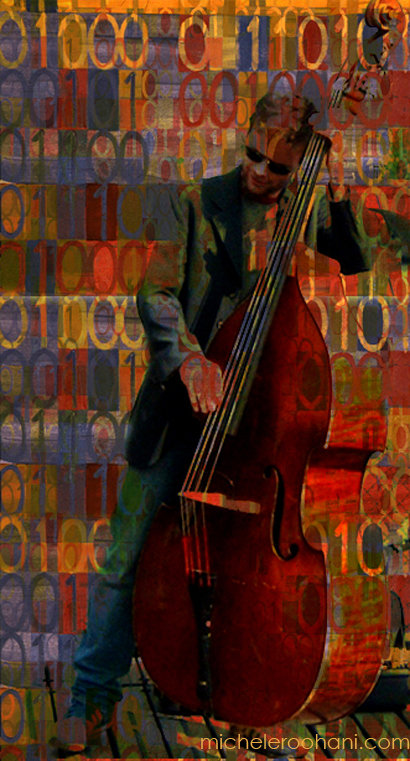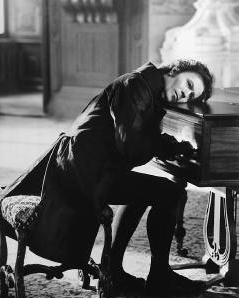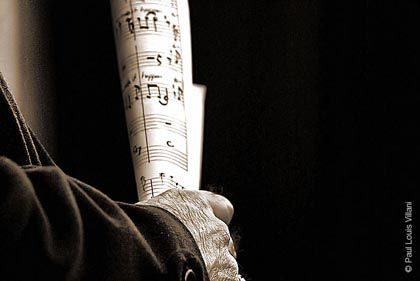I am in love with my iPod. One fabulous podcast i listened to last week brought tears to my eyes and inspired me to make this image.
the radio program was the one about the “Musical DNA” from WNYC’s Radiolab. David Cope , a composer and professor at UCSC, talks about how a computer program he wrote, can imitate the musical DNA of great artists; “His program, named EMI (Experiments in Musical Intelligence – pronounced Emmy), deconstructs the works of great composers, finding patterns within their compositions, and then creates brand new compositions.” Imagine some undiscovered pieces from Mahler or the Almighty Bach…Life can be amazing. We have worshiped dead musicians for ever, can we admire their ghosts’ music now?
I love this picture of Gary Oldman playing a near deaf Beethoven in Immortal Beloved. I often wonder how different his music would have been were he not deaf…
I just discovered this great image from Paul Louis Villani, a photographer and digital artist, i met on redbubble.




Most interesting. I used to imitate Mozart, Bach and Chopin on the piano. It is good that
I don’t have to do that any more.
Askin Ozcan
First of all, thanks for creating the image. I love the way it blends classical and digital, musical and visual.
Culture should grow, evolve, and adapt. By listening to Cope/Emmy’s music and knowing the process used to create them you were inspired to create a beautiful piece of art. If Cope hadn’t done his work you would never have done yours. I understand that the connection between the Cope/Emmy cyborg and the classical composers that were used as a basis for the pieces may be too close for comfort for many of those who revere their works. But since this inspired you and probably others to create, they have definitely served a good purpose.
Just wanted to say that I absolutely love your site. I am reading, listening, enjoying, etc. I am glad that a friend of mine in California forwarded the URL to me.
Very nice graphic.
I love the scene in Immortal Beloved when Oldman’s character (Beethoven) puts his near deaf ear to the piano and plays the Moonlight sonata. You can feel his passion and wretched longing for the vanishing notes. The pain of his ebbing hearing is perceptible. Oldman does a great job for the part in this movie.
Oh, also, RadioLab is a great program. Also a favorite of mine on my iPod. I highly recommend a previous and recent show on the “Placebo Effect”. Actually, all their shows are great!
The musical dna — yes that was far off — no it didn’t scare me, neither did it impress me. Machines merely ape that which the human brain can do. the ‘underlying patterns’ are not new to seasoned listeners among whom figure other composers. they can hear, aknowledge these patterns, even incorporate some of them in their own work — you hear this being done by Beethoven (vis-à-vis Haydn and Clementi) in his early work, noteably in the 1st symphony. in that work there are very haydenesque moments and yet every note bears the indellible stamp of the young genius.
In brief this mechanical dna — appologies to Mr D. Cope — will not engender new life, but mere ear pleasing — cuz we’ve somehow heard it before — ear-clone-candy.
Just now listened to : Variations on a Theme of Frank Bridge, Op 10, by Benjamin Britten and then ‘Sarah Was Ninety Years Old’ by Avrö Part (performed by the Hilliard Ensemble — ECM records) Brilliant. In the end, I can’t cope w Mr Cope.
An act like this is prepared within the silence of the heart, as this is a great work of art. Like great works, deep feelings always mean more than they are conscious of saying. Finding patterns within the compositions of the great ones, be it a fugue of Bach, or…..creates a window of possibilities which one may mechanically imitate or duplicate the march of notes, but can it recreate the sense of the Masters? Can technology interpret Carmingnola’s Interpretation of Vivaldi’s late concertos, as in Concerto in F major RV295 IL larghetto?
It will be a day to pause when a computer program can reproduce and expand upon what brings tears in your eyes and channels your creativity to portray the cool bassist with the choir of mathematical numbers
behind him.
Until then, I will enjoy
the dead masters
and this tableau
imagining what if……
while my carriage takes me
to the valley of the Jacarandas!
Thanks for the comment, Michele!
I love the image you created. In fact, all your work is pretty awesome. Keep it up 🙂